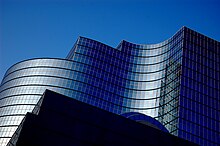WGNO
Tribune acquired WNOL-TV in 2000, but the stations' operations were not integrated in one facility until July 2005—a month before Hurricane Katrina evicted them from the New Orleans Centre.
In the wake of the hurricane, WGNO lacked permanent studios for two years; it produced local newscasts from a compound of trailers and with anchors reporting from outside for months, but there was little ratings movement.
[17] Two bids were initially received for $151,000, but neither were satisfactory to the trustee, who wanted to offer more money to the creditors whose liabilities totaled $1.4 million.
[16] One of the original bidders, a consortium of New Orleans investors known as Communications Corporation of the South (CCSI), increased its offer to $300,000 and was accepted; the new owners also announced their intention to repair transmission equipment damaged in a fire and expressed their admiration for the staff's ability to keep channel 26 going "with essentially nothing more than gum and baling wire technique and inadequate equipment".
[7][1] Mark Lorando, television columnist for The Times-Picayune, described WWOM-TV/WGNO-TV from 1967 to 1983 as "an artfully bad independent station",[12] while one of his predecessors, Benjamin Morrison, noted that its local programming "offered levels of amateurishness previously undreamed of".
[20] Local programming during this period included such shows as the music program Homegrown; monthly teen magazine Hey Kids, It's For You; Black Is..., a discussion show about issues in the local Black community; and the Groovy Guru, future WDSU weathercaster and former radio DJ Dan Milham hosting movies.
[22] In 1978, WGNO-TV was purchased by Greater New Orleans Television, a subsidiary of General Media Corporation of Rockford, Illinois, for $4.9 million.
[24]) Under General Media, the station moved its transmitter to a new, purpose-built tower that offered greater height than the International Trade Mart building and provided for a power increase from 500,000 to 2.5 million watts.
A group led by Hal Protter, Channel 38 Associates, built WNOL-TV, which began broadcasting in March 1984 and immediately had an impact on the market with credible ratings.
[31][32] Tribune brought to WGNO its considerable clout as a buyer of programming on the syndication market and its other resources as a company,[14] which it would need to overcome the "shoestring" management style of General Media and face its new competition at WNOL-TV.
[43] On August 25, 1994, it was announced that SF Broadcasting—a partnership with minority-owned communications firm Savoy Pictures in which Fox held a minority stake[44]—would acquire three Burnham stations, including WVUE.
After Jones returned, several WNOL advertising staffers applied for jobs at WGNO, already under the impression that their station would not be the ABC affiliate.
[48][49] As FCC approval of the SF Broadcasting purchase was delayed by more than a year because of a commission inquiry as to whether Fox was a foreign-owned company as a result of Rupert Murdoch's interest, ABC opted to strike first.
[53] While such a trade was arranged for WGNX, Tribune took WGNO off the market after the legalization of duopolies in November 1999; this allowed it to acquire WNOL-TV outright and create the first such pairing in New Orleans.
[54][55][56] The stations were combined under WGNO's general manager; WNOL began to air prime time news breaks promoting channel 26's late newscasts.
[58] Hurricane Katrina devastated the New Orleans area in August 2005 and led to years of operational challenges for WGNO and WNOL.
[72] In becoming an ABC affiliate, WGNO committed to building the first new TV newsroom in New Orleans since WWL-TV signed on in 1957 and increase its overall staff from 65 to 110.
It featured a high story count and fast pace and was aimed toward a younger audience than the existing newscasts in New Orleans.
[81][82] However, the Project for Excellence in Journalism gave the station's news output one of the lowest grades in the country and criticized it for covering too many car accidents.
[83] While ratings had steadily increased in the late 1990s, they slipped badly in May 2002; the station posted year-over-year viewership declines of 20 percent or more for each of its three daily newscasts.
[84] Daniels moved from anchoring sports to news later that year,[85] an experiment that accompanied an overhaul of the station's newscasts with new visual elements and weekly contributions from Virgets.
[90] After that, newscasts began originating from an outdoor set on a nightly basis, using an anchor desk salvaged from the New Orleans Centre studios and a variety of cobbled-together equipment in "The Compound" of double-wide trailers.
[95] On January 31, 2011, WGNO reformatted the 6 p.m. newscast as News with a Twist, a newsmagazine format that focused on lighter stories and commentary and was mostly unscripted.
[101] The station's signal is multiplexed: The 54.2 and 54.3 subchannels of WUPL is broadcast on WGNO as part of the market's ATSC 3.0 (NextGen TV) deployment plan.




